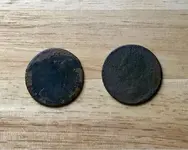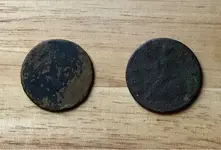A lot of my sites have ultimately become party spots so in many cases I've got iron and modern trash to contend with. I'm not sure how effective pitch would be in such an environment, but perhaps you can provide me with advice regarding this as I know that you have a lot of experience with pitch. I am absolutely crushing it this year with full tones and zero discrimination but I'm open to trying different settings. I don't ever use the horseshoe, what's your opinion of running full tones with some discrimination given this scenario?
Great finds. I definitely believe you should hit it again with 25 khz. Hitting a site like that with different frequencies and from different directions can frequently pay off. Even if you think you have pounded it, some targets hit in only one direction or only at certain frequencies due to what is around the target, and no one is so disciplined in their swing patterns that they can say they got their coil over every inch of ground at a given site. So hitting a site repeatedly at different frequency settings is more important than the disc and tone tweaks I discuss below.
Regarding full tones and disc...
First of all, I am firm believer in the adage, "If it ain't broke, don't fix it." If something is working for you, stick with it until it doesn't. Your finds show things are working pretty well. In any event, I will give you my reasons why I have moved away from full tones/0 disc (I was a big fan of that the first few years I owned a Deus) and have gravitated to mostly pitch based detecting with the Deus using disc between 7 and 10. I set reactivity based on junk density (making sure that silencer stays at -1 (off) or I set it there myself if it has "auto changed" with the change in reactivity setting - an XP advanced settings quirk). You can decide for yourself if it is worth experimenting with or trying out disc and pitch/multi-tones.
The key here is mostly discrimination but I will talk tones here. Pitch helps with unmasking ferrous from non-ferrous. If your site does have a lot of non-ferrous junk (as you mentioned), however, it does make sense to go with multi tones (3, 4, or 5) instead of pitch, if you are using discrimination.
The reason I do not recommend Full Tones when using disc is that you absolutely cannot hear iron while in full tones when any disc applied because Iron Volume does not work with full tones. Also, it really is impossible to differentiate the mid tones into discoverable targets. Anyone who says you can tell the difference between a nickel and pull tab or between a zincoln and wheatie because they are using full tones is simply imagining things. The human ear/brain cannot do that unless the person has been trained as a baby to associate specific pitch tones with targets. About the most we can handle/discern for the average person is around 5 tones. On some detectors, such as the Equinox, I like to use 50 tones in some cases only because it gives me a good audible feel for the stability of the target ID (and I have to remove discrimination anyway regardless of the number of tones I am using to listen to ferrous on Equinox), which on that detector is good indicator of probable junk targets. But on the Deus, target ID tends to jump around more so full tones is less useful. Furthermore, full tones tend to blend together, especially if target ID up or down averaging is occurring due to the presence of nearby ferrous or even large non-ferrous junk. I still use full tones/0 disc on occasion, when I don't need to apply discrimination, but I have found myself using it less and less the more I have gotten used to pitch or multi tones. The tonal quality clues on irregularly shaped targets are just as audible in multi-tones or even pitch as they are in full tones, so I have not found full tones to really be advantageous vs pitch or multi.
If you want to hear iron tones so that you can differentiate from non-ferrous (in pitch mode or two-tones) or so that you can determine if you are in higher density iron indicating a past human presence, then either use Full Tones with no disc or disc with iron volume and pitch or any multi-tone scheme of your choice (I like 5 tones, but 3 or 4 tones works too). The key with any pitch or multi-tone setup with disc, is that if you get a faint, but clean non-ferrous tone even if you do not get a target ID, you should dig it. The horseshoe can help with this because even with no target ID, if you get a non-ferrous blip tone, you should also be able to see a small non-ferrous tic mark on the horseshoe, indicating a deep non-ferrous target. Dig it. The horseshoe, however, is only accurate/stable with at least 6 units of discrimination applied, according to XP. That takes us on to discrimination...
XP designed the Deus to work with discrimination and the discrimination filter used in the Deus/ORX is pretty impressive. Not just in it's ability to filter out ferrous (which is not unique to discrimination filters on most VLF induction balance detectors), but also in it's ability to use that filtering to clean up down/up averaged Target ID's and tones and also because I have found that even with high disc settings it has surprisingly little impact on depth. At settings above about 15 you do noticeably affect depth, but not as much as you would think. I don't advocate running disc above 10, but the point here is that you should not be concerned that you are affecting depth by using reasonable levels of discrimination. I have found that using discrimination at around 7 to 10 helps to clean up and better unmask non-ferrous targets in high iron density situations because down averaging is mitigated. It helps with horseshoe operation, and iron volume means that you never have to miss out on audible ferrous tones (if desired) while using the other benefits of discrimination.
Hope this helps.








